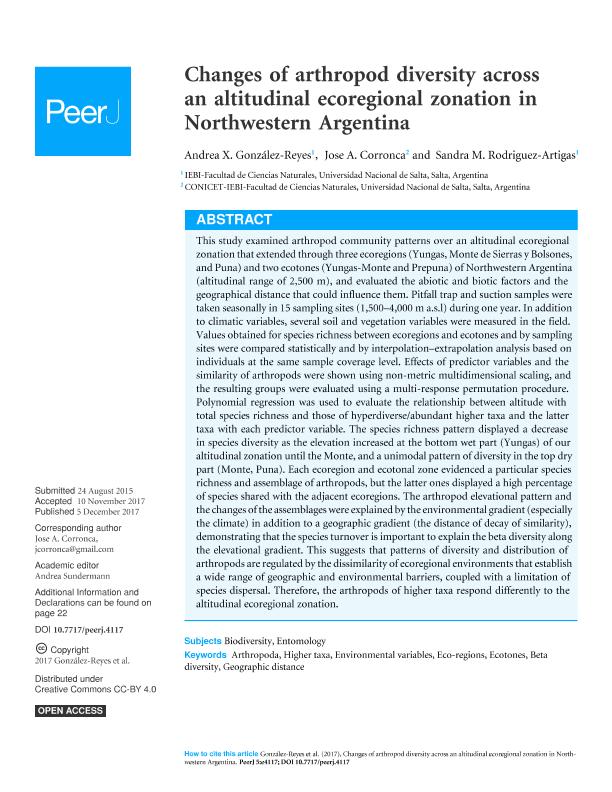Artículo
Changes of arthropod diversity across an altitudinal ecoregional zonation in Northwestern Argentina
Fecha de publicación:
11/2017
Editorial:
PeerJ Inc.
Revista:
PeerJ
ISSN:
2167-8359
Idioma:
Inglés
Tipo de recurso:
Artículo publicado
Clasificación temática:
Resumen
This study examined arthropod community patterns over an altitudinal ecoregional zonation that extended through three ecoregions (Yungas, Monte de Sierras y Bolsones, and Puna) and two ecotones (Yungas-Monte and Prepuna) of Northwestern Argentina (altitudinal range of 2,500 m), and evaluated the abiotic and biotic factors and the geographical distance that could influence them. Pitfall trap and suction samples were taken seasonally in 15 sampling sites (1,500-4,000 m a.s.l) during one year. In addition to climatic variables, several soil and vegetation variables were measured in the field. Values obtained for species richness between ecoregions and ecotones and by sampling sites were compared statistically and by interpolation-extrapolation analysis based on individuals at the same sample coverage level. Effects of predictor variables and the similarity of arthropods were shown using non-metric multidimensional scaling, and the resulting groups were evaluated using a multi-response permutation procedure. Polynomial regression was used to evaluate the relationship between altitude with total species richness and those of hyperdiverse/abundant higher taxa and the latter taxa with each predictor variable. The species richness pattern displayed a decrease in species diversity as the elevation increased at the bottom wet part (Yungas) of our altitudinal zonation until the Monte, and a unimodal pattern of diversity in the top dry part (Monte, Puna). Each ecoregion and ecotonal zone evidenced a particular species richness and assemblage of arthropods, but the latter ones displayed a high percentage of species shared with the adjacent ecoregions. The arthropod elevational pattern and the changes of the assemblages were explained by the environmental gradient (especially the climate) in addition to a geographic gradient (the distance of decay of similarity), demonstrating that the species turnover is important to explain the beta diversity along the elevational gradient. This suggests that patterns of diversity and distribution of arthropods are regulated by the dissimilarity of ecoregional environments that establish a wide range of geographic and environmental barriers, coupled with a limitation of species dispersal. Therefore, the arthropods of higher taxa respond differently to the altitudinal ecoregional zonation.
Archivos asociados
Licencia
Identificadores
Colecciones
Articulos(CCT - SALTA-JUJUY)
Articulos de CTRO.CIENTIFICO TECNOL.CONICET - SALTA-JUJUY
Articulos de CTRO.CIENTIFICO TECNOL.CONICET - SALTA-JUJUY
Citación
Gonzalez Reyes, Andrea; Corronca, Jose Antonio; Rodriguez Artigas, Sandra Mónica; Changes of arthropod diversity across an altitudinal ecoregional zonation in Northwestern Argentina; PeerJ Inc.; PeerJ; 2017; 12; 11-2017
Compartir
Altmétricas




